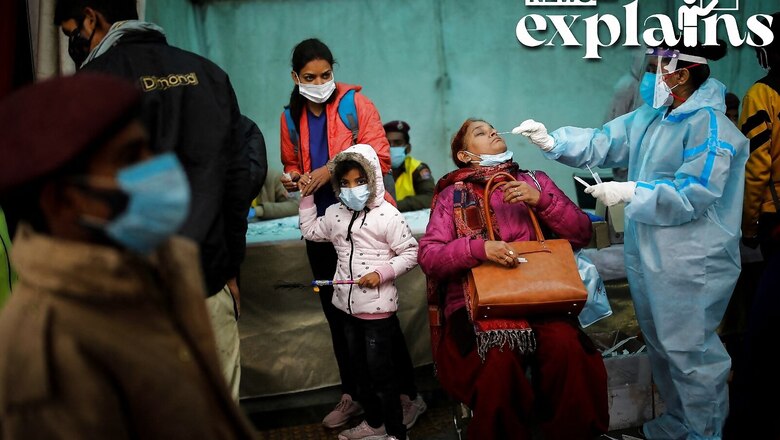
views
Just as the world was getting used to a new normal with the assumption that it was the end of the road for Covid-19, the virus that wreaked havoc across the globe seems to be making a comeback, with neighbour China once again in the throes of a major wave.
According to Chinese local news, some residents in Beijing have to wait for days to cremate relatives or are paying a steep fees to secure timely services, indicating a growing death toll amid a sharp rise in coronavirus cases.
The new and highly transmissible BF.7 strain of the Omicron variant has been blamed for the surge in China. A sudden spurt in cases has also been witnessed in Japan, the United States of America, the Republic of Korea, and Brazil.
Reviewing the entire situation, Union health minister Dr Mansukh Mandaviya on Wednesday directed top officials to up vigilance.
“Covid-19 is not over yet. I have directed all concerned to be alert and strengthen surveillance. We are prepared to manage any situation,” the minister announced in a tweet from his official handle.
The number of Covid-19 cases in India, so far, has not highlighted any concerning trend. According to sources, four cases of BF.7 have been found in the country but there is no confirmation from the Centre yet.
Government data shows that India has been witnessing a steady decline in cases, with average daily cases falling to 158 in the week ending December 19. However, a consistent rise in global daily average cases has been reported in the last six weeks, with 5.9 lakh daily average cases reported in the week ending December 19. So far, there is no noticeable spike in hospitalisation numbers in India.
No need to panic, just up the surveillance game: Experts
According to Dr Anurag Agarwal, former Head of INSACOG and Institute of Genomics and Integrative Biology (IGIB), while there is no cause for worry for India, remaining cautious and upping the surveillance game is an obvious move.
Dr Arun NM, an internal medicine expert who is a member of the state Covid-19 taskforce, echoed the same view.
“Variant BF.7, which comes from the Omicron family of BA5 127, is not new. In fact, Europe and other countries have reported this variant starting September. These countries have high coverage of Covid-19 vaccination and have witnessed multiple waves of variants. There was no major impact caused by the strain in these countries.”
With these new variants, he said, the US and Europe haven’t seen any pick-up in the severity of illness or hospitalisation. “A similar situation is in India where vaccination coverage is high and people have been infected once or twice with natural infection as well. We can assume that in India also it may not cause any concern.”
Dr Arun believes that vaccines used in China might not be of higher quality as their efficacy is not as high as that of other shots. “Their vaccines were not good, their vaccination coverage is also questionable as there is no clear data on the same,” he said, adding that it would be incorrect to compare the Chinese situation to India. “We need to be cautious but there is no reason to be in panic mode.”
What’s happening in China?
According to the Institute of Health Metrics and Evaluation, China could see a major Omicron epidemic in the coming months, with 3, 23,000 deaths expected by April next year.
Vinod Scaria, scientist at CSIR’s Institute of Genomics and Integrative Biology (IGIB), explained in a Twitter thread that the aggressive approach by China to contain the virus, following initial cases in Wuhan, which included quarantine and lockdown, massive testing and surveillance, early vaccines and health infrastructure, has been seen with admiration.
“While Covid-19 spread across the rest of the world, infecting and killing millions of people, and putting healthcare infrastructure to the brim of their capacities, China remained isolated, contained the spread and remained an outlier in many aspects,” he wrote.
“The virus continued evolving making it fitter — more transmissible and with better capacity to evade prior immunity (immune escape). This caused multiple waves across the world, with “variants of concern (VoC)” named as they emerged and spread across the world,” he added.
Scaria went on to say: “Fast forward into 2022, we have a much better version of the virus, thanks to millions of infections over 3 years. The omicron subvariants including recombinants are much adept at evading immunity acquired with vaccines or prior infection.”
The thread added: “While the world has be slowly crawling back to normalcy, suffering huge losses in lives, and learning to live in a pandemic with masks, vaccines, boosters & antivirals, and suffering multiple onslaughts/waves of infections, China was isolated in many ways.”
“We don’t in fact know much of what variant is dominant in China, since the genomic surveillance data is scanty and often not available in public domain to make any logical conclusions. One can only safely assume an Omicron sublineage.”
Need to take China more seriously?
According to Dr Vishal Rao, member of the Genomic Surveillance Committee, Karnataka, and Director of Head and Neck Oncology at HCG Cancer Hospital, the current situation in China cannot be dismissed by the rest of the world.
“We assume that when the initial epidemic of SARS-CoV-2 D614G occurred, it was a forerunner to the disease occurring somewhere around October, and the world received some form of forewarning throughout December. By March, we were aware that the world was under siege.”
Rao warns: “If we contemplate a similar trend, we must recognise that China should be regarded more seriously than we think. These zero Covid-19 policy lockdowns could be an underlying warning of something more sinister that China may not be currently communicating.”
The doctor added that in the next few months, global health authorities will have an enormous obligation to watch independently and intensively, as will global health communities and worldwide governments. “There is an urgent need for worldwide genomic surveillance, as well as the interchange of timely and accurate information, to avert subsequent apocalyptic catastrophes on the scale of present concerns about antibody-enhanced diseases and endemic illness outbreaks.”
Modi govt accelerates efforts
While Mandaviya has been informed that there is no evidence of increased severity of Covid-19 cases in the country so far, India needs to be on alert mode.
The minister has told officials to sensitise people once again about maintaining social distancing. With focus on upcoming New Year parties and gatherings, the government will try and raise awareness about hand hygiene, following social distancing norms and wearing masks.
There was also a lull in terms of booster dose uptake as Covid-19 seemed to have faded away. But now, the minister has advised officials to start promoting booster shots, especially for those with co-morbidities and compromised immunity.
The department of pharmaceuticals and ministry of AYUSH have also been directed to review drug availability in the country.
The departments will now conduct a stock review of medicines which were used in the first, second and third waves, including oxygen availability and hospital beds.
In terms of surveillance, samples will be pulled out and tested from sewage water, incoming travellers at airports and usual samples taken by Indian laboratories for Covid-19 testing. These will be randomly sent for genome sequencing, which will help in upping surveillance to detect the strains circulating in the country.
Apart from detecting new strains, the government has asked officials to test the efficacy of vaccines used in India — majorly Covishield and Covaxin — against the new strains in question.
Read all the Latest Explainers here

















Comments
0 comment